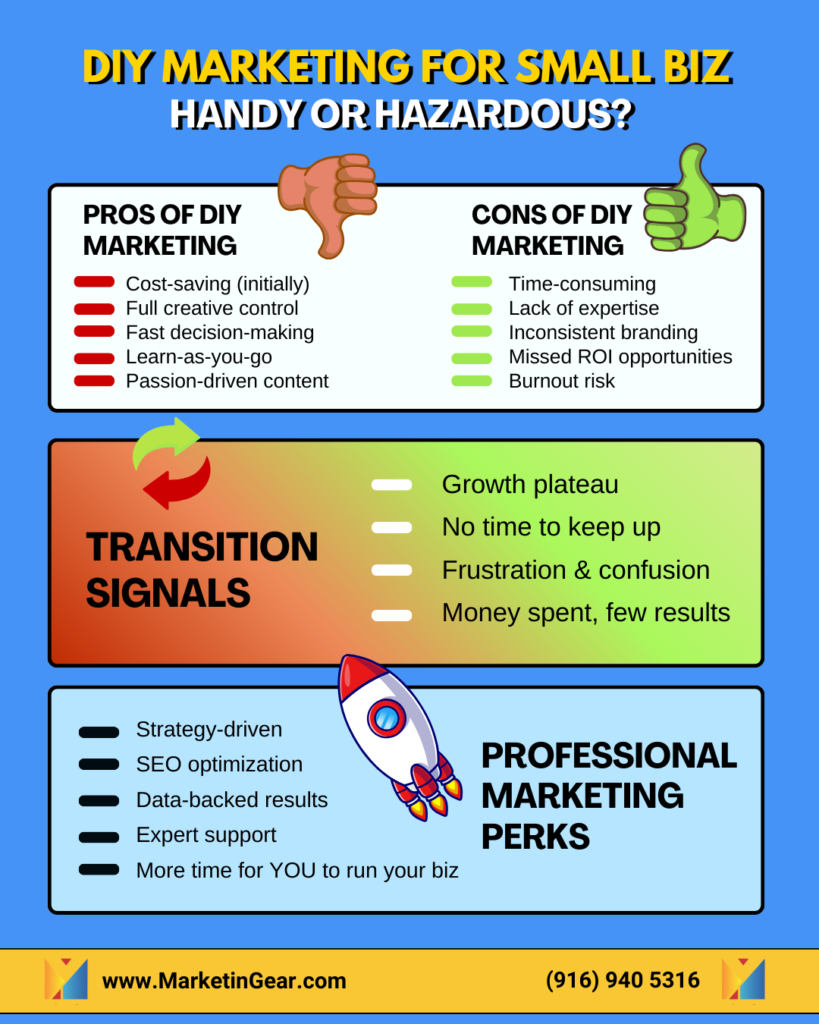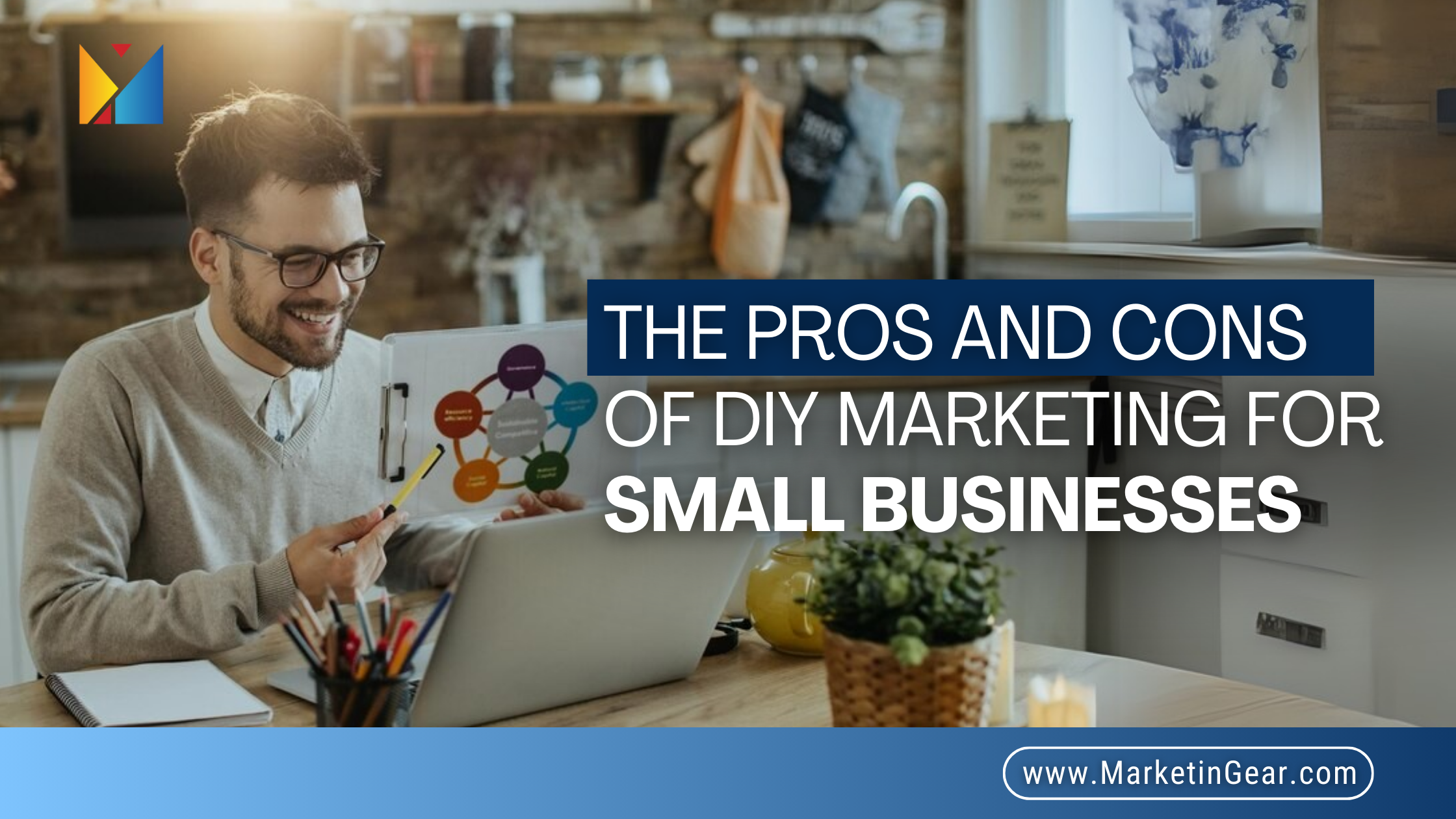Introduction: The Temptation of Going It Alone
Starting a small business is like planting a seed and hoping it grows into a strong, fruitful tree. You’re watering it with passion, shining light on it with dedication, and protecting it from storms with every ounce of strength you’ve got. Naturally, when it comes to marketing, many small business owners think: “Why not do it myself?”
DIY marketing can feel empowering, like baking your first loaf of bread. You choose the ingredients, mix it your way, and if it rises—oh, the pride! But if it flops, you’ve wasted time, money, and energy.
So, is DIY marketing a wise choice? Or is it a pothole on your road to success? Let’s break it down together, step-by-step, with a warm cup of honesty and a sprinkle of strategy.

Section 1: What Is DIY Marketing?
DIY (Do-It-Yourself) marketing means handling all your business marketing efforts yourself. No agencies, no hired experts—just you (maybe with a little help from YouTube or ChatGPT).
Typical DIY marketing activities include:
- Managing social media
- Designing your website with tools like Wix or Squarespace
- Running Google or Facebook ads
- Creating your own email campaigns
- Writing blogs or newsletters
It’s like being a one-person band—juggling drums, guitar, and vocals while trying to stay on beat.
Section 2: The Bright Side – Pros of DIY Marketing
1. Cost-Effective (At First) If your budget is tight, DIY can seem like a no-brainer. You’re not paying anyone else, and many tools are free or low-cost.
2. Full Control You know your brand best. DIY marketing allows you to express your vision exactly how you imagine it.
3. Quick Decisions No need to wait for approval or back-and-forth emails. You act fast and pivot faster.
4. Learning Experience You’ll gain hands-on experience with marketing tools, platforms, and strategies.
5. Passion-Driven Messaging Your messaging is heartfelt. After all, no one believes in your brand like you do.
Real Story: Anna, a bakery owner in Oregon, designed her own Instagram posts, ran weekly promos, and attracted 1,000 followers in 3 months—all without spending a dime. She knew her audience loved cupcakes, so she shared “behind-the-frosting” videos and her personality shone through.
Section 3: The Shadows – Cons of DIY Marketing
1. Time Suck DIY takes time—time you could use to improve products, serve customers, or take a break. Marketing becomes a second full-time job.
2. Lack of Expertise Without the right know-how, your efforts may miss the mark. A poorly optimized ad or a generic blog won’t bring in results.
3. Inconsistent Branding Your materials might lack polish or consistency. One Canva post might look pro; the next one, not so much.
4. Missed Opportunities Without professional tools and insights, it’s easy to overlook what’s trending or what your competitors are doing better.
5. Burnout is Real Trying to juggle everything leads to stress, fatigue, and poor results.
Real Story: Ben, a handyman in Florida, spent months learning Google Ads but ended up wasting $700 with no real leads. He later hired a marketing expert who doubled his bookings in 4 weeks with the same budget.
Section 4: When DIY Works Best
- Early Stage Startups with minimal budget.
- Creative Businesses (like artists or crafters) where personal voice is essential.
- Short-Term Projects or quick campaigns.
- Owners with Marketing Backgrounds who just need the right tools.
Tip: Focus on platforms you’re comfortable with. If you love video, stick with short-form content on TikTok or Instagram Reels.
Section 5: When DIY Starts to Fail
- Growth Plateaus – You hit a wall, and leads slow down.
- Time Crunches – You’re too busy running the business.
- Lack of ROI – Your DIY marketing isn’t generating enough returns.
- Confusion & Frustration – You’re constantly Googling “Why my Facebook ad didn’t work.”
If marketing starts to feel like a full-time hustle instead of a tool to support your growth—it’s time to reconsider.
Section 6: Transitioning from DIY to Professional Marketing
1. Audit Your Current Marketing Where are your leads coming from? What’s working? What’s not?
2. Set Clear Goals Do you want more brand awareness, more sales, or better customer retention? Clear goals help guide your next steps.
3. Choose the Right Partner Find a marketing agency (like MarketinGear!) that understands small businesses and offers full-service solutions.
4. Start with a Hybrid Model You can still create content while letting experts handle strategy, SEO, or ad management.
5. Track Performance Together Make data-driven decisions with your team. Monthly reports, clear KPIs, and honest conversations matter.
Conclusion: DIY or Don’t—You’re Still the Boss
DIY marketing is like home-cooking—sometimes it hits the spot, and other times, it’s burnt toast. It can be fun, rewarding, and budget-friendly. But when your business is ready to grow, bringing in professionals isn’t a failure—it’s a smart upgrade.
At MarketinGear, we help small businesses transition smoothly from DIY marketing chaos to clear, strategic growth. Whether you need a complete marketing package or just a few expert tweaks, we’re here for you.




